To keep your perfumes fresh longer, incorporate base note essential oils like sandalwood, vetiver, and patchouli as natural fixatives. These oils evaporate slowly and help anchor lighter scents. You'll want to blend them at 5-10% concentration with carrier oils like jojoba or sweet almond. Store your blends in dark glass bottles at steady temperatures between 15-20°C, away from light and heat. The right combination of these preservation techniques can transform your perfume's staying power.
The Science Behind Essential Oil Preservation
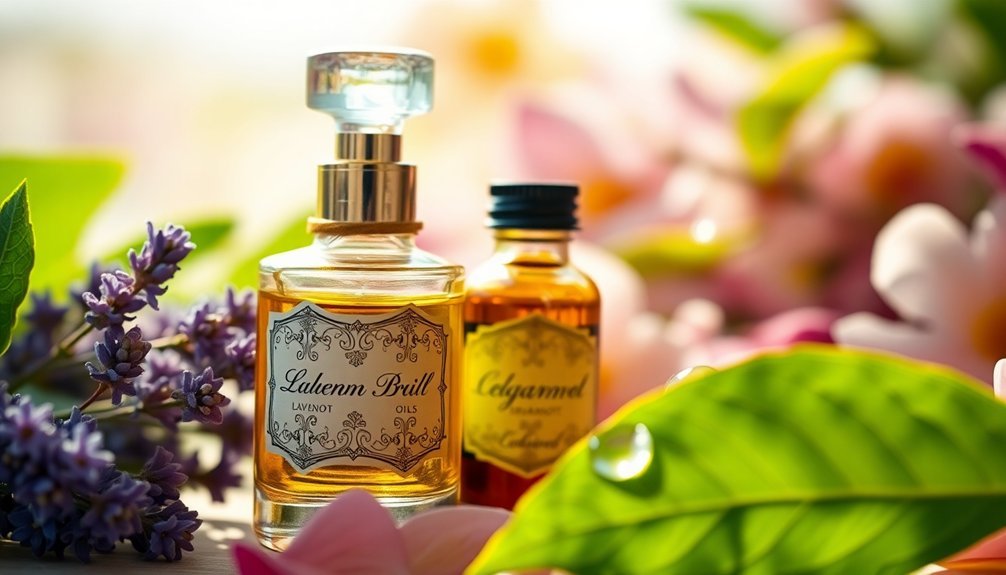
Preservation plays an essential role in maintaining the quality and potency of essential oils for perfumery. When you're working with essential oils, you'll need to understand how chemical stability affects their longevity.
The absence of alcohol in essential oils helps maintain their original scent characteristics for longer periods.
Heavier molecules, like those found in patchouli and sandalwood, naturally evaporate more slowly, making them excellent choices for long-lasting fragrances.
You'll get the best results by storing your essential oils properly. Keep them in dark glass bottles away from heat and light, as these elements can break down their molecular structure.
Avoid plastic containers or rubber droppers that might contaminate your oils. Temperature fluctuations are your biggest enemy, so find a cool, dark spot for storage.
Understanding these preservation principles helps you maintain your oils' freshness and guarantees your perfumes retain their intended scent profile longer.
Top Essential Oils for Extending Perfume Life
When you're crafting long-lasting perfumes, certain essential oils stand out for their superior staying power. Base notes like sandalwood and vetiver offer exceptional longevity while maintaining strong odor impact. You'll find these oils particularly effective when applied to pulse points or layered with scented body lotion.
To maximize your perfume's lifespan, opt for high-quality oils extracted through steam distillation. These concentrated formulations interact naturally with your skin chemistry, creating a more enduring fragrance. Adding carrier oils like jojoba or sweet almond oil helps dilute the essential oils while extending their wear time.
While top notes like peppermint deliver immediate impact, they'll dissipate quickly. Instead, focus on middle and base notes for extended wear.
Remember to store your oils properly in cool, dark places and keep bottles tightly sealed. You'll also achieve better results by dabbing rather than rubbing the oils onto your skin.
Creating Synergistic Preservative Blends
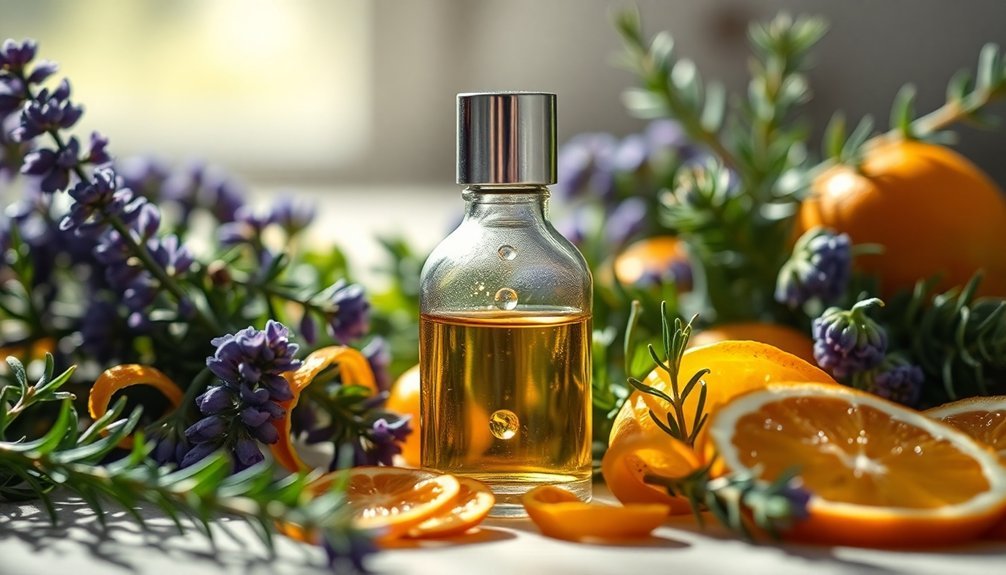
While perfume longevity depends on quality oils, proper preservation guarantees your blend stays fresh and stable over time.
Based on industry standards showing high essential oil percentages in professional blends like Headache EO & FO Blend 586 at 84%, incorporating concentrated essential oils helps maximize fragrance preservation.
You'll want to combine essential oils with proven preservatives like Phenoxyethanol or Optiphen Plus for ideal protection.
Remember that while oils like Oregano and Tea Tree offer antioxidant properties, they won't prevent microbial growth on their own.
- Mix 190-proof grain alcohol at 20-30% concentration for an effective DIY preservative system
- Blend essential oils with Potassium Sorbate in acidic formulations for enhanced stability
- Consider using Glycerin at 50% concentration for antibacterial properties, though it will thicken your blend
Natural Fixatives From Essential Oils
You'll find patchouli essential oil serves as one of the most effective natural fixatives, creating a rich foundation that anchors your perfume's lighter notes.
Vetiver can extend your fragrance's wear time considerably when you add 2-3 drops to your blend, especially in woodsy or masculine compositions.
For an enhanced fragrant experience, try combining frankincense with your chosen top notes, as its warm, resinous qualities help stabilize the overall scent profile while adding depth to your creation.
Patchouli Base Notes Guide
As one of perfumery's most powerful natural fixatives, patchouli essential oil stands out for its rich, earthy aroma and remarkable ability to extend a fragrance's longevity.
When you're creating your own perfume blends, you'll want to keep patchouli to 5% or less of the total oil content for best results. This versatile base note works exceptionally well with myrrh, sandalwood, lavender, and several other essential oils while helping to slow down the evaporation of more volatile components.
- Stabilizes and enhances other fragrance notes, making your perfume last longer on the skin
- Adds depth and complexity to your blends while offering therapeutic benefits like relaxation
- Blends seamlessly with other natural fixatives such as vetiver, cedarwood, and frankincense
Consider using patchouli in combination with carrier oils for direct skin application or in diffuser blends for atmospheric benefits.
Vetiver Longevity Tips
Known for its extraordinary fixative properties, vetiver essential oil stands among the most effective natural ingredients for extending perfume longevity.
You'll find this deep, woody oil can slow down the evaporation of volatile fragrance components while stabilizing other scent notes for up to 10 hours on skin.
To maximize vetiver's fixing power, opt for higher concentrations in your perfume formulations, similar to luxury eau de parfums.
When blending, you'll get the best results by combining vetiver with spicy or smoky accents, though it also works beautifully with citrus notes for a fresh twist.
Don't forget to test a small sample first – vetiver's unique earthiness can be surprisingly intense.
For extra staying power, apply your vetiver-based perfume to fabric, where it can last up to two days.
Frankincense Fragrance Enhancement Methods
While vetiver excels in fixing perfumes, frankincense brings its own remarkable stabilizing properties to fragrances. When you're looking to enhance your perfume's longevity, frankincense's warm, resinous qualities will help slow down the evaporation of volatile components while adding complexity to your blend.
- Combine frankincense with myrrh for a luxurious, long-lasting base that anchors lighter notes.
- Add citrus oils like bergamot or neroli to create a balanced fragrance that's both grounding and uplifting.
- Include pink pepper to enhance the zesty profile while maintaining frankincense's elegant edge.
To achieve the best results, you'll need to balance frankincense carefully with other notes.
Use premium ingredients and blend with precision to avoid overwhelming subtler aromas. This attention to detail guarantees your perfume maintains its sophisticated character while lasting longer.
Storage Methods for Enhanced Longevity

Proper storage methods can dramatically extend the life of your essential oil perfumes and preserve their intended fragrances.
You'll want to keep your perfumes in a cool, dark place where temperatures remain steady between 15-20°C. Don't store them in your bathroom, where humidity fluctuates, or near heat sources like radiators.
Always keep your perfumes in their original packaging for maximum protection against light and temperature changes.
When you're using your perfume, make sure you're closing the bottle tightly after each use to prevent oxidation. Handle the bottles gently and keep them upright to minimize air exposure and potential leakage.
While you might think it's a good idea, don't store your perfumes in the refrigerator – the condensation can damage the fragrance molecules and alter the scent.
Blending Ratios and Proportions
When creating your essential oil perfume, you'll need to mix your chosen oils with a carrier oil at a ratio of 10-20% essential oils to 80-90% carrier oil.
Start by combining your base notes, which should make up 30-40% of your essential oil blend, ensuring they're thoroughly mixed before adding other notes.
You can experiment with different base note combinations like sandalwood and vanilla or patchouli and frankincense to create your desired foundation.
Carrier Oil Mixing Ratios
The art of blending carrier oils with essential oils requires precise ratios to create safe and effective perfumes.
Start with a basic ratio of 1 part fragrance oil to 10 parts carrier oil, then adjust based on your desired scent strength. When working with jojoba or sweet almond oil as your carrier, maintain a 10-20% fragrance concentration for ideal results.
- Mix 80-90 drops of carrier oil with 10-20 drops of fragrance oil for a balanced blend
- Use glass containers and precise measuring tools like pipettes for accurate mixing
- Allow your blend to mature for 48 hours to one month in a cool, dark place
Remember to test your blend on a small patch of skin first, and don't hesitate to adjust the ratios until you achieve your desired fragrance intensity.
Base Note Combinations
Building upon carrier oil ratios, base notes serve as the foundation of your perfume composition. When you're creating your blend, start with a basic 20-30% base note proportion to achieve a well-balanced fragrance.
You'll want to experiment with combining different base notes like sandalwood, vanilla, and vetiver to create depth and complexity. For longer-lasting perfumes, you can increase the base note percentage while maintaining harmony with your middle and top notes.
Try pairing amber with musk, or tonka bean with oakmoss to enhance the fixative properties. Remember to let your blend mature for several days, allowing the chemical compounds to interact naturally.
This waiting period helps round out the scent profile and guarantees your base notes properly anchor the fragrance, giving you that desired long-lasting effect.
Testing and Stability Guidelines
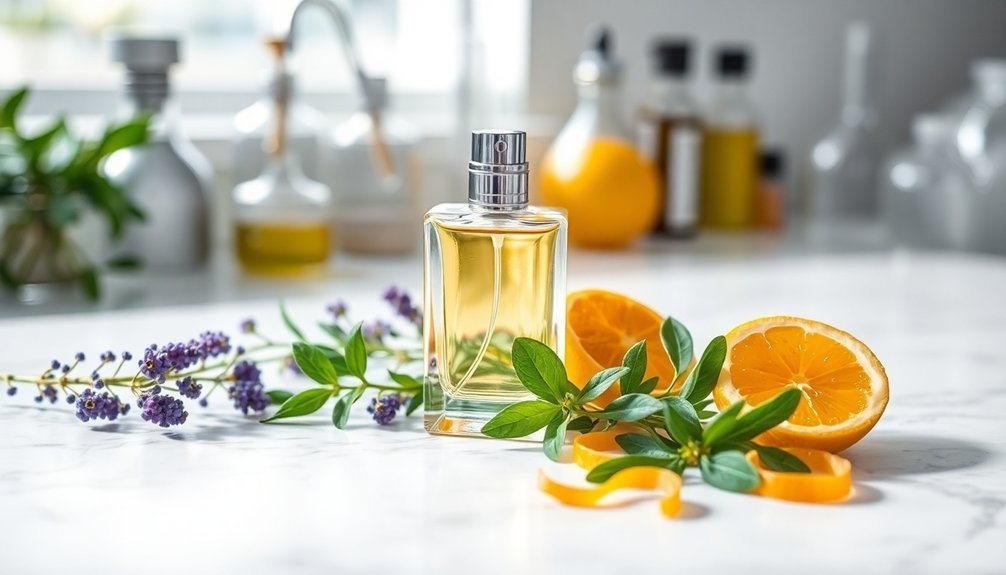
Maintaining proper testing and stability guidelines guarantees your essential oil perfumes remain potent and pure throughout their shelf life.
You'll need to regularly check your oils for any changes in color, consistency, or scent that might indicate degradation. When storing your perfumes, always use dark glass bottles with airtight seals and keep them in a cool, dry place away from direct sunlight.
- Test your perfumes monthly by placing a drop on a testing strip to evaluate if the scent profile remains consistent.
- Label each bottle with the opening date and expected shelf life to track freshness.
- Monitor storage conditions to ascertain temperatures stay between 60°F and 70°F, avoiding areas with high humidity or temperature fluctuations.
Remember to transfer oils to smaller containers as you use them to minimize air exposure and prevent oxidation.
Carrier Oil Selection for Preservation
Proper carrier oil selection greatly impacts the longevity and stability of your essential oil perfumes. You'll want to choose carriers that enhance preservation while maintaining the integrity of your fragrance blends.
| Carrier Oil | Benefits |
|---|---|
| Jojoba | Stable, odorless, mimics skin's natural oils |
| Fractionated Coconut | Stays liquid, lightweight, non-greasy |
| Sweet Almond | Vitamin-rich, nourishing, light texture |
| Grapeseed | Non-greasy, antioxidant-rich, preservative properties |
| Argan | Nutrient-dense, moisturizing, slight nutty undertone |
When selecting your carrier oil, consider both preservation and skin compatibility. Jojoba oil is often the top choice due to its remarkable stability and skin-like properties. If you're looking for a lighter option, fractionated coconut oil provides excellent preservation while maintaining a weightless feel. Sweet almond and grapeseed oils offer additional skin benefits while helping extend your perfume's shelf life.
Frequently Asked Questions
Can Perfume Oils Be Layered With Commercial Fragrances Safely?
You can safely layer perfume oils with commercial fragrances, but you'll need to test for compatibility first. Avoid mixing with alcohol-based scents and start with small amounts to achieve your desired combination.
How Often Should I Rotate My Perfume Collection to Maintain Freshness?
You should rotate your perfume collection every 2-3 months, using older fragrances first. Check each scent's condition and prioritize using perfumes that are closer to their expiration date to maintain ideal freshness.
Do Different Skin Types Affect How Long Essential Oil Preservatives Last?
Yes, your skin type considerably impacts essential oil preservative duration. You'll notice oils last longer on oily skin, while dry skin absorbs them faster, requiring more frequent application to maintain their preservative effects.
What's the Maximum Shelf Life for Perfumes Preserved With Essential Oils?
You'll get the longest shelf life of 3-5 years when using patchouli or sandalwood as preservatives in your perfumes. Store them properly in dark glass bottles at cool temperatures to maximize longevity.
Can Essential Oil Preservatives Change the Original Scent of My Perfume?
Yes, essential oil preservatives can alter your perfume's original scent. You'll notice subtle changes as these oils interact with the fragrance components, though you can minimize this by choosing complementary preservative oils that match your perfume.
In Summary
You've now learned how essential oils like patchouli, vanilla, sandalwood, and frankincense can greatly extend your perfume's lifespan. By using these natural fixatives and following proper storage methods, you'll get more mileage from your fragrances. Remember to test your blends, stick to recommended ratios, and choose appropriate carrier oils. With these techniques, you're well-equipped to create long-lasting, naturally preserved perfumes that maintain their integrity.


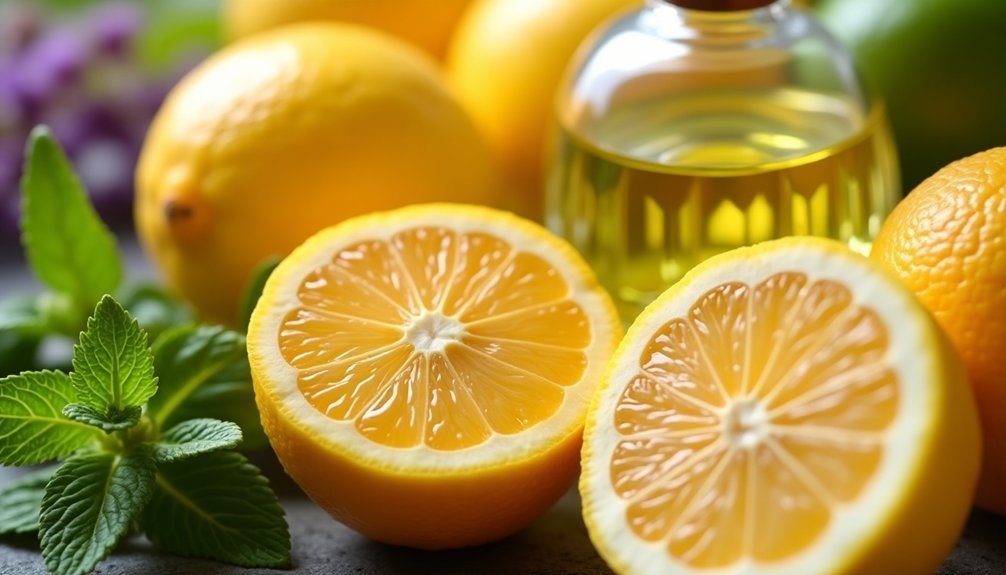
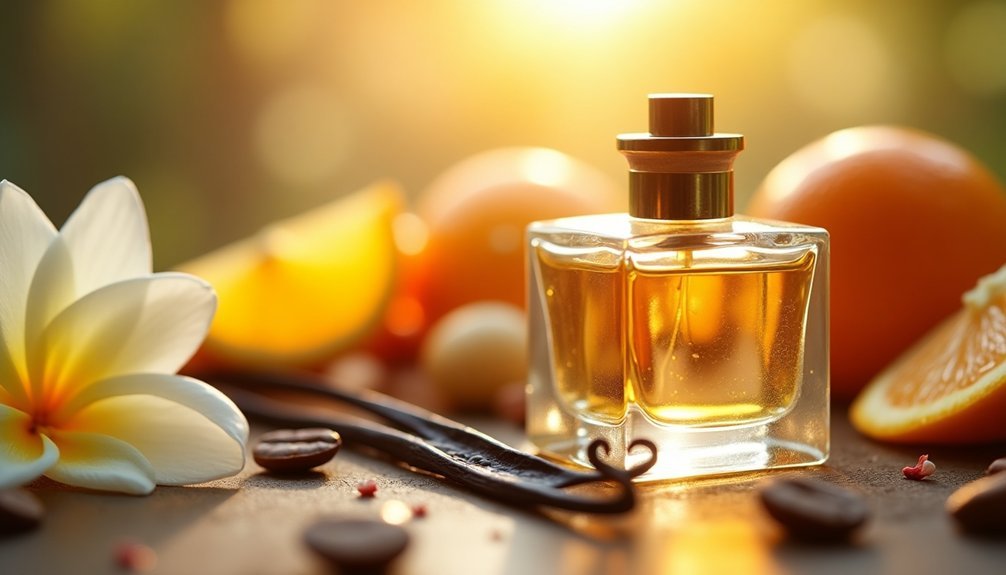

Leave a Reply